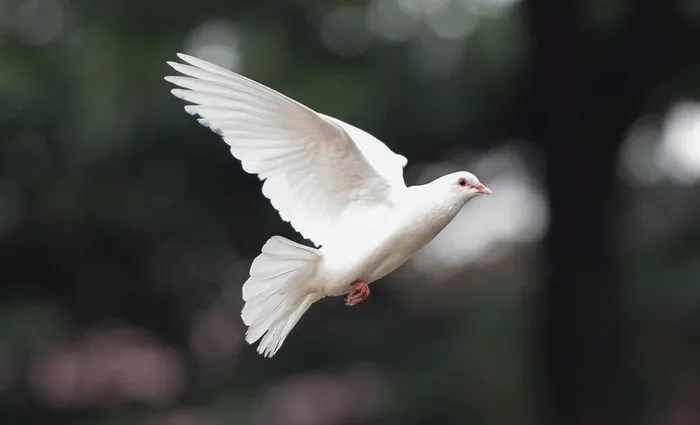It's a custom-made marriage
From around the globe

In the Philippines, they release a pair of white doves to signify a harmonious union. In South Africa, we do that at a funeral.
Image: Pixabay
WEDDING bells are ringing somewhere all the time. My recent column on my godparents’ 50th wedding anniversary was a milestone celebration. And last week, if my precious parents had still been alive, on June 6, they would have rung in their 65th wedding anniversary.
In a world filled with infidelity and the like, the above two examples would seem like part of Aesop’s fables. Following on that theme, I decided to take a gander at wedding and marriage customs worldwide. Some are downright scary. Others are hilarious. However, if the couple want approval, they need to put up a brave façade.
Let me begin with quoting an old chestnut: What are the three most important things in a wedding ceremony? Apparently, they are “aisle, altar and hymn.”
However sexist folklore insists that the bride agrees but spells it differently. She apparently reads it as: “I’ll alter him."
For fear of spending tonight in the dogbox, I will refrain from elaborating on that.
Okay, let's begin our journey around the world. I believe that is sometimes a term used at a honeymoon. Wedding customs are practised to basically create a link for the couple to their lineage or culture. As they say different strokes for different folks.
In the Philippines, they release a pair of white doves to signify a harmonious union. In South Africa, we do that at a funeral. Ouch! We better not mistakenly juxtapose that.
The wedding tradition in Norway is for the bride to wear a crown and as the bride moves, the silver and gold charms encrusted in the crown create a tinkling sound, which apparently scares off the spirits. In my view, which I will be accused of being chauvinistic for, is that the bride is already establishing her role as queen of the union from the get go.
In a similar vein, in Mexico, at a wedding there is “el azo”. It is a lasso (like in the westerns), a strong string of rope, which is draped around the shoulders of the couple. Basically, tying them up in a union and the figure eight shape resembles the infinity sign, which onlookers hope will be realised through time. To me, it’s is just too convenient a tool to sort marital problems out, albeit, too permanently.
Here's a strange one. Wedding rituals in the Congo dictate that for the duration of the ceremony, the couple are not allowed to smile. The reason they are given? It is said that if one grins during the ceremony, it shows that they are not serious about the marriage. My take is that it is preparing them for the rest of their lives. Marriage is not for sissies. It is no laughing matter.
This next one spells danger. In China, a prospective groom shoots at his bride several time with a bow and arrows. Okay the arrows are headless. Afterward he collects all the arrows and breaks them during the ceremony to ensure their love lasts forever. To me this ritual should come with a caveat. Heaven forbid that the bride’s mother-in-law does not like her. Slipping a fully formed, real arrow amidst the others would be a cinch. The marriage will be on target.
Staying with China, in another region, the custom dictates that the bride can’t go to the groom’s home on foot. She is escorted in a regal chair, which is elaborately made up and is carried by her female attendants. Heaven help those women if the bride is extra proportionately built.
In the Czech Republic, before a wedding ceremony, the well-wishers place a real-life infant on the marital bed to symbolically signify fertility. Thank goodness the symbolism is limited to one infant, or else it would be Czechmate to their finances.
In Nigeria, many tribes signal the start of the event by breaking the shell of a bitter fruit known as the Kola nut. Thereafter, the guests break off as much of the symbolic fruit as possible, which symbolises the amount of prosperity the guests and hosts will enjoy. In the real world, after the wedding ceremony, that’s when the “nuts” really get cracked regularly.
In Russia, the newlyweds enjoy a wedding sweetmeat called “karavay”. Whoever takes the biggest bite, without using their hands, is to be considered the head of the family. I think it would be the one with the biggest mouth, and no guesses on that aspect.
All these weird and quirky rituals are routine to those concerned. I believe the real deal starts after the wedding. Communication, empathy, sympathy, loyalty, etc, is what matters. By the way, my wife told me to say that.
Disclaimer: the writer swears that he is not a male chauvinist porker, a bigot or a snob. As always, he says it like it is with no fear or favour… till death does him part!

Ravi Govender
Image: Supplied
* Ravi Govender is a former POST sub-editor and Lotus FM radio presenter. He is a published author, a freelance editor and film producer in training. He can be contacted at: [email protected]
** The views expressed do not necessarily reflect the views of IOL or Independent Media.